Confessions of An Old Vaudevillian
By David Soren (known in vaudeville as Howie Davis)
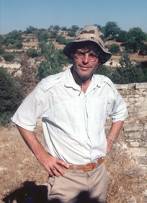
Regents Prof. David Soren in the ruins of Kourion, Cyprus in 1986
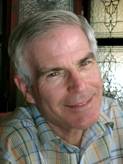
David Soren today
For Prof. David Soren's life after his Vaudeville years click here
Read about the new Vaudeville Museum at the University of Arizona here
If you love Vaudeville and want to contribute to the preservation of this collection send your tax deductible contribution to Special Collections , University of Arizona Libraries, PO Box 210055, Tucson, AZ 85721-0055
It is often said that sound movies and radio and the Great Depression killed vaudeville in the early 1930s but if that is true it was a long slow death. In fact all across America vaudeville shows lingered up to the early 1960s and performers were even doing blackface until that date!
When I entered vaudeville in 1954 as a kiddie entertainer under the name of Little Howie Davis, it was still thriving surprisingly well and we still packed 'em in at venues such as Asbury Park in New Jersey and Palumbo's Nightclub at 8th and Catherine Streets in Philadelphia. I got into vaudeville like many poor city kids from broken homes. My divorced mother worked as a bookkeeper for a dress shop until they told her to stay away from it one day because they were burning the building down to get insurance. Suddenly she was unemployed and told to keep her mouth shut! She taught French on the side, and claimed she tutored Mario Lanza (we never knew if she was telling the truth!) and eventually found more clerical work.
There was no such thing as day care then and kids in elementary school usually walked home for lunch since there were no school cafeterias either. With no money for a baby sitter I was on the streets at lunchtime either eating at local hash houses or going to a friend's house for peanut butter or bologna. After school when I was 8 or so I would often get taken by someone to the Germantown Boys Club to hang out until mom could get me.
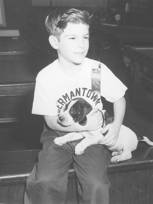
At the Germantown Boy's Club
The Boys Club was like Disneyland to me. Tough Hispanic teens shot pool on the ground floor but I never was much good at the game and the place was full of young hustlers. In the other wing classes were given in Indian lore and they staged pageants with the kids as Leni Lenape Indians.
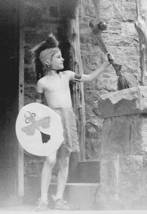
As a Leni-Lenape Indian brave
I did this for a while but the old guy who ran it kept over-adjusting my loin cloth in his private office and perspiring behind his stogey. I had a street kid's instinct to get the hell out of there so I fled upstairs where I found paradise. Here was Dorothy "Aunt Dot" Wagner's dance studio, a huge room with wooden floors and an old upright piano played by "Aunt Edna".
Through warm and wonderful Aunt Dot, the Boys Club produced large vaudeville shows, often with an Irish flavor for the locals, hosted by the great old man Pat Cronin. He was 16. The hit songs were I Had a Hat When I Came In and I'll Have a Hat When I go Out! The rehearsals contained lots of cute girls wearing leotards and very interested in all the boys. I mustered my courage, produced a current sheet music of a song called I Need You Now, with Eddie Fisher on the cover, and my whirlwind life in vaudeville suddenly began.
Right from the start Aunt Dot told me I had natural stage presence and I must learn to be versatile. In those early days after school she taught me voice, tap and ballet plus encouraged me to do impressions both of singers and dancers. Since my mother had taken up with an alcoholic man who beat us both and periodically trashed the house when he wasn't working in the post office, I was eager to hang out with Aunt Dot and learn everything she could teach because here and in school I was getting the recognition I never got at home and I treasured all forms of learning because I saw it as an escape from home and poverty. Thank God for teachers!
Pretty quickly I became one of Aunt Dot's kiddie stars and I was sent out all over the area to do radio, television, nightclubs, Kiwanis type shows, and fairs. I was in road shows with Chief Halftown, the full blooded Seneca Indian who hosted local children's shows for WFIL tv, the ABC affiliate, for almost 50 years. I appeared often with the Chief, who always had a no nonsense attitude backstage when he was responsible for organizing everything but when the show opened he was all smiles. He must have been good because although I worked with him in his early days, he stayed on from 1951 to 1999! He began each show with E Sta Sa Sessaway, or something to that effect, which is Senecan for Let's Get Started. He really loved kids whom he called his tribal members in a gentle, loving voice, but if things didn't go right he knew a few expletives too. He died in 2003 at the age of 86. He worked on children's shows until he was practically in the grave.
Another local superstar and legend I worked with a lot was Sally Starr, who always called herself Your Gal Sal and who never refused her fans an autograph which she invariably signed Love, Luck and Lollipops!
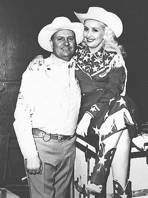
Sally Starr and Gene Autry
Like the Chief, she was another one of WFIL tv's kiddie show hosts, with something called Popeye Theater. I remember working with her in radio and she said that I was to do my impression of Frankie Laine and then do a dance to Shine, a pop hit of the time. And she told me not to move around too much because of the fact that the microphone was stationary. I remember thinking who cares about listening to tap dancing on the radio but that's what they wanted me to do! Sally was a short and slightly chunky but incredibly striking blonde with long hair, a great cowboy hat and a western blouse and skirt complete with silver stars and fringe, not to mention her holster with six-guns! She was a mother figure or sex symbol depending on how old you were but I remember her being very patient and sweet and reassuring when the kids forgot their routines. Her real name was Sally Aline Mae Beller and she had been a country disc jockey before hitting it big in Philadelphia television. She always signed off with May the Good Lord Be Blessing You and YOUR Family!
Both the Chief and Sally hosted vaudeville shows with all kiddie performers, with the audiences being adults and kids and we almost always played to full houses. Pretty soon I was working at Palumbo's Nightclub downtown, one of the few places in Philly with a proper stage. I was opening for comedy acts like the Radio Aces, who I think were three guys, if I remember correctly, who did funny singing and dancing and came out of the Catskills circuit.
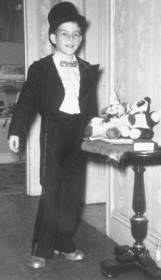
Ready for a show at Palumbo's
In the nightclubs in those days people drank and ordered light food and watched one or two shows a night with about four acts whereas the vaudeville shows could have as many as 15 acts around 7 minutes each. In vaudeville a lesser act usually mopped up the show, in order to encourage people to leave, but in the nightclub the feature attraction always came last and performed longer. At Palumbo's I rated the second of four spots, right after an Italian tenor with a slightly wobbly vibrato singing Oh Mein Papa like popular Eddie Fisher, and I was followed by a block act, those people who balanced on props and put blocks together as they climbed stairs! I remember they were a man and woman who were always half naked in their dressing rooms with their door open and they were fighting over any mistakes they made and blaming each other. I remember thinking it was a tough way to make a buck!
Another nice middle aged fellow I opened for at venues like the Rosalima Church (big crowds of screaming kids and cute little girls seeking autographs!) was Pete Boyle, the father of actor Peter Boyle.
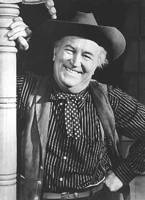
Pete Boyle
Peter was there sometimes too but we never paid much attention to him and I was amazed when he became a huge star as a character actor as we didn't notice anything special about him at the time. He was a teenager by then and not in our juvenile group. Pete Senior was a TV celebrity for the NBC affiliate and therefore a rival to Sally and the Chief. He usually wore a sort of bow-tie with polka dots and dressed like he'd come off some old chuckwagon. He had so many shows on that it seemed every time you turned on morning or lunchtime TV he was there with cartoons, Little Rascals, western movies, and his warm smile and anecdotes. He used to travel with a little hand puppet that all the kids loved named Snooper or Snoopy the Squirrel and the they would ask about him as if he were real! After I did my songs, dances and impressions, Pete would come out with the oddest act. He would tell a few stories and then open up the mike to the kids and ask them what he should draw. Then he would draw funny things on an easel with a crayon and make jokes and at the end he gave each drawing to the requesting kid. I thought it was an awful act but the kids loved it. He had to draw the images really simply and big to be seen from so far away but he actually was a pretty good sketch artist and was certainly a pleasant man. His main period of popularity was from 1950 to 1960 by which latter time he was aging pretty rapidly and may have been ill. He died around 1969.
I played a lot of Kiwanis and Optimists Clubs. There would be 5 or 6 acts. In the Philadelphia area the headliners were often the Philadelphia Eagles football players. They would often close the show by lecturing about football and they might even play a little piano or sing if they could. It's hard to believe now but pro football players didn't make much money in those days so they'd pick up an extra $100 to $500 by doing these shows and I would open for the likes of Chuck Bednarik (the center) or Jesse Richardson (the tackle).
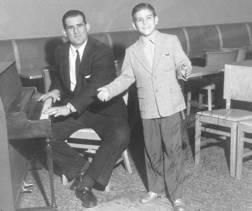 .......
.......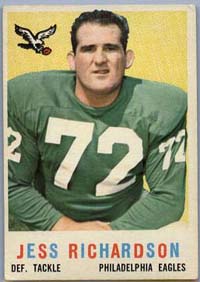
Rehearsing with Jesse Richardson
These were a nightmare for vaudevillians. You had no small orchestra like you could have at Palumbo's, only a pianist whom they provided. These alleged musicians varied in quality and often couldn't keep an even tempo. You always signaled the beat to them by counting it out before you began but half the time these bastards played the tempo they felt like no matter what they were playing and it was either too fast or too slow. Sometimes they played everything in ragtime, even slow tunes. So you learned quickly to adjust to this Scott Joplin mentality. If they played too slowly and I was tap dancing, I would add taps to pad out the regular steps. If they played too fast, I would simplify the routine in order to keep up because I couldn't do all the steps so quickly. Learning this at age 8 helped me a lot in later life to stay cool under fire no matter what happened.
Another problem with small venues was the absence of proper stages . There were instead large carpeted rooms, which were fatal to a tapper, so you had to carry with you a tap dancing board. The size of it was determined by how large a board you could carry and tie on to the top of a car or get on a train. The board was square and you learned your tap routines two ways, first with a proper stage where you used the total available space. Then you learned the routine entirely within the limits of your board. Sometimes you borrowed chairs and put them around the board and tapped against them, using them as props. This was called prop dancing and you adjusted to a variety of chair designs by rehearsing an hour before your performance. I got so I could tap off of damn near anything and still can to this day. There were also little portable stairs you could bring into a small space and set them up to do a stair dance like the ones made famous by Bill "Bojangles" Robinson with Shirley Temple. Sometimes an acrobat would bring these stairs with him or her and would walk up and down them on their hands! These props became part of the dancer's gear in the early 20th century when there were no proper dancing surfaces and you lacked space!
A vaudeville tap dancer had to do a little of everything to survive. If you couldn't really dance and were faking your way through you were a hoofer, like a Lucille Ball or a Bing Crosby or a Danny Kaye. Dancers couldn't stand to watch them dance because they were so awful. Prop dancers used stairs, chairs, canes, top hats, jump ropes, hoops and even roller skates. I was a prop dancer. Acrobatic dancers infused tap routines with somersaults and splits like The Nicholas Brothers or even Donald O'Connor did in their prime. In fact the Nicholas Brothers combined prop dancing with prop stairs, acrobatic leaps and ballet and even walked up walls at the edge of the stage and somersaulted into splits on hard wood or bakelite floors. Fred Astaire and Ginger Rogers combined ballroom dancing, ballet and tap in a graceful manner which they had derived from earlier ballroom dancers such as Vernon and Irene Castle. There were comic dancers of whom the most popular masters were Ray Bolger and Donald O'Connor. Bolger was gangly and seemingly awkward. He could do amazing slow splits and his legs often seemed to have a life of their own, propelling his surpised and unwilling upper torso in an unexpected direction. O'Connor was more athletic with high energy, mugging and frenzied footwork but he was a superb tapper and acrobat. Many people don't realize how incredible a ballroom dancer he was and how adept at partnered dancing. In fact I found him much more talented overall than Astaire or Kelly. He could do so many more things than they could but he was known for being a comical dancer and so was never appreciated for his genius.
While I am digressing about types of dancing I studied and the dancers I admired, let me also mention stunt dancing which was quite dangerous and which was pioneered in the teens of the 20th century by Fred Stone. Such dancers combined tap, ballet and death defying stunts. Gene Kelly had an overinflated reputation in this area but the greatest of our era was Russ Tamblyn who could literally dance through the air two stories up with no fear of injury. A former gymnast, Russ would soar to great heights without a net, catapulted by springboarded seesaws or he would swing off of a high bar into a handstand. All of the dancers admired him and later, much later, he became a good friend of mine. Now his daughter Amber is a superstar emmy nominee for Joan of Arcadia on tv!
There was also adagio dancing where the male flung his partner all over the map, putting her head suddenly close to the ground in dangerous drops and spins. There was also a kind of rubber legged dancing called Legomania that few people remember where you wobbled your legs and did steps and strutting at blinding speed resembling a quick Charleston but you tapped intricately while you were doing it. Hal Leroy, a long thin funny faced guy, was the acknowledged master of this from the late twenties on up into the fifties. He was even admired by the great black dancers. There was also quiet tapping where you seemed to walk around the stage calmly but the audience would hear a lot of extra taps. There was never a real name for this and it was always called doing a Bill Robinson. This was a specialty of black dancers and Sammy Davis Jr. and more recently Gregory Hines were the greatest at this that I ever saw.
Black dancers normally dressed up to perform. I was told that it was to set them apart from their contemporaries and to show people they were important. It was also considered a gesture of respect to the white audiences who granted them the privilege of performing for them. One other type of dancing that was popular in the Irish areas was waltz clogging. Clogging went back as far as anyone can recall and was definitely Irish and one of the great cloggers was, of all people, Gracie Allen (yes, that Gracie Allen!). Pat Rooney used to do a kind of clogging routine to waltz tempo that I liked to imitate after singing East Side West Side. Rooney was still known in the 1950s in the Irish community although his golden age was back in the teens.
The only dancer I ever saw who mastered every aspect of dance was a woman—Vera-Ellen, who was our goddess, the consummate dancers' dancer. As a solo tapper, ballerina, paired dancer with Astaire or Kelly or O'Connor, adagio dancer, comic dancer, modern dancer, prop dancer (including roller skates), stunt dancer (including death defying plunges from second stories) or acrobatics she had no equal. She could also sing passably on Broadway but was always dubbed in the movies. She was a great dramatic actress who could cry on cue like her Cincinnati neighbor Doris Day. And she was beautiful. Dancers admired her perfect fluid transitions from step to step. Her all too few films included Wonder Man, The Kid from Brooklyn, On the Town, Happy Go Lovely, White Christmas, Words and Music and Three Little Words. To this day I cannot watch footage of her without weeping at the perfection of her art and the lack of appreciation for her brilliance which has condemned her to the ranks of the forgotten.
Of course Astaire and Kelly were the most famous dancers but they weren't the best. When they partnered with Eleanor Powell, Vera-Ellen, Donald O'Connor or the Nicholas Brothers the partners were NEVER allowed to go full throttle and outshine these venerable stars because Astaire and Kelly had CONTROL in their films. They worked with the best but toned them down. Thus the public never realized that these other dancers were far more versatile. What Astaire and Kelly had was grace of movement and a certain look. Astaire was streamlined and fluid, perfect for the Depression Modern style of the thirties. Kelly had a gorgeous body and was masculine and infused dance with storyline and emotion. But they were hardly the best dancers of their age in terms of versatility.
Black people could not attend our shows. They technically could but it was understood that they were absolutely not welcome. Although we were dirt poor, they had their own clubs and theaters on the other side of the other side of the tracks. So I never worked with a "Negro" but I did perform constantly in blackface. You see I was a 9 year old Jolson impersonator and I sang Mammy on bended knee in what made older people nostalgic and younger people laugh. My face was doused with burnt cork from a minstrel kit I carried with me and my lips were outlined with cold cream from a big blue jar. I wore oversized white gloves and was otherwise dressed in a black suit. I listened to Jolson LPs all the time and he had enjoyed a big revival at the end of his career, entertaining troops and basking in the glow of two biographical films with Larry Parks.
Sometimes the burnt cork would stay on my face for days. Because I was a local star and on tv all the time many of my fellow students at Edwin H. Fitler Elementary School hated me without knowing me because the little girls would come up and ask for autographs. They all thought I was a NATIONAL star because I came on the same tv screen where they watched Milton Berle or Sid Caesar and they were too young to know that I was just a local personality. My teachers would constantly tell the class how lucky they were to have such a talented young man in their midst and they hated that more than anything and would whisper that I wore eyeliner and lipstick like a girl. The boys were so mean when I was between 8 and 12 and I couldn't understand what there was about me that they hated so much. They thought I deliberately kept the makeup on to show everyone how important I was and they taunted me with cries of pretty boy. It took me years to deal with this and I can understand how young stars often have problems adjusting when everyone seems to hate them and then suddenly they lose their star status. It seems as if you are left with nothing for all your trouble—no friends and no career-- and everything you have done is wrong. It made me painfully shy and distrustful of people. When I was 12 I made a point to never talk about myself to anybody unless directly asked by someone, a policy I maintain to this day.
Non-vaudevillians don't understand how much traditions meant to us. When certain songs were done, you did them the same way year after year for decades. For example we used to do a comic song and dance tune called Down By the Winegar Woiks (Down by the Vinegar Works). It had originally been done in the 1920s and was a salute to the rough, common, illiterate folks who lived on the other side of the tracks with us. The lyrics were raw and it became an anthem to the working stiffs because it talked about how tough you had to be to survive in the depths of the city. To perform it you dressed like a poor twenties tough, wearing black pants and a black and white horizontally striped shirt. I never knew anybody who dressed that way except for Gene Kelly in An American in Paris but when the number had been done it was always done that way by vaudevillians. When we did it in 1954 we had to get special clothes made! To this day I don't know why and when I asked the old-timers they simply said that this was the way it was done!
In 1956 I joined The Horn and Hardart Children's Hour in Philadelphia located in WCAU CBS Studio One at City Line Avenue.. I was 9 I think, one of the youngest regular cast members they had, although some guy named Jerry Donahue had been taken by them at age 5 years before. I was certainly the youngest of this bunch though. They paid for singing lessons for me, and acting coaching, and I remember that it became hard to stay in regular school, do my vaudeville shows and rehearse my parts for the show plus attend rehearsals, singing lessons and the actual live performance every week. I became a team with a young and very cute girl named Cheryl and we sang songs such as Sioux City Sue, I'm Blue Every Sunday, and our big one On the Beach With You, for which they built us a beach set with parasols and brought in actual sand onto the soundstage!
The one thing I really recall about the Children's Hour is that all the little girls were gorgeous. Unlike public school where you were around "ordinary people" as we called them in our little niche at WCAU, everyone here or nearly everyone was gorgeous and talented and smart too, because if you couldn't adapt to the vagaries of live tv you were gone in a hurry, and everything did often go wrong. The Children's Hour, I learned later, was the most prestigious kiddie show you could be on in Philadelphia. It had been founded by Stanley Broza (who insisted on being called Stan LEE Broza). He was a big bald headed guy with lots of energy who founded the show on radio in 1928. Since that time many famous stars got their start on it. I can remember that the Nicholas Brothers and Kitty Kallen the band singer were on. A sister show was started successfully in New York City but the Philly show was the original. By 1948 it was one of the first radio shows to successfully make the transition to tv and featured such future greats as Eddie Fisher. It was on Sundays from 11:30 to 12:30 at WCAU.
I remember that we were always told to follow little marks in tape on the floor and to keep an eye out for the red eye of the camera. There were two and they switched periodically so you needed to sing, move, watch the camera eye and watch your marks all at once. Not everyone could learn to do it NATURALLY. If you were mechanical and were caught glancing down at your spot, you were out. You had to FLOW through it gracefully, and there was little rehearsal time so you saw what you had to do twice through in rehearsal, then were left to visualize it in your head over and over, and then do it on Sunday live. It got easier over time but initially it was pretty tough, especially since in those days they needed to flood the stage with light and you could honestly not see much. We did a lot of salutes to musicals or composers and a lot of tributes to our servicemen. Holidays were sure fire, especially Christmas, Thanksgiving or Armistice Day which I think is now Veteran's Day, where you could always whoop up the live studio audience of about 300 by waving the flag and dredging up George M. Cohan. I remember a lot of marching and saluting!
Horn and Hardart was a cafeteria chain or automat as it was called where you could get fast food for little money. You put a quarter or small change into a slot, the door opened and you pulled out a lemon meringue pie that you had first glimpsed behind a little glass windowed compartment. In Philly Horn and Hardart were famous for their baked beans. Their motto was Less Work for Mother Dear which I knew because all the commercials were done live on the show and there was a jingle we had to sing with stupid words about mom and making her life a pleasure because she gets to go to this automat and not cook all the time. It would never fly today. Stanley or Stan LEE rather was only there on show days. He used to emcee the show but he had been hired away to a rival network and left the show's production to his wife Esther who didn't seem to like kids, fought with everybody and seemed to be perpetually in a snit about something. On show days, all her preparations were made and then her husband would host the show, immediately after which he left. It seemed clear that this was not going to work out too well in the long run and it didn't. The show went on hiatus for the summer of 1958 and never returned. It was never actually cancelled after 30 years—that would have upset a lot of WCAU viewers. It just died a quiet but ignominious unfeted death.
I remember there was a brother and sister singing and dancing act on the show called the Marianos (Bobby and Patty, I think) that everyone seemed to like but Bobby Mariano was 12 and he hated me at first sight. Everyone was always saying that I could become another Bobby Mariano but I didn't want to because he was so mean to me and I never knew why. Dean Stolber was another guy who was a superstar there at that time. He couldn't sing or act or dance well but he was incredibly handsome. Even the boys thought he was handsome and the girls there and in the audience just came to get a glance at him. He had the most fan mail which was the big gauge of your status. Being kids, we needed recreation when we weren't performing and the Brozas never thought of looking after us so we went behind the studio and used the wall outside to play Chink, a bounce ball game with a tennis ball. I was pretty athletic then and Dean came over and asked me to join the group that played with him back there. After that, I was kind of in with everybody. Dean was very normal, not swell headed or jealous, and I remember hearing that he went inside show business and became a wealthy executive. I hope this is true because he was always a sweet guy and wore his good looks with modesty and helped me fit in with the other regulars.
I left the show late in 1957 when my family moved to Levittown, Pa. Although I continued to perform in successful folk and rock groups until I turned 20, I never again did vaudeville and I soon realized that with the death of the show in 1958 came the death of vaudeville once and for all in the Philadelphia area. The headliners that the oldtimers used to talk about were quickly forgotten and quickly nobody spoke of Eva Tanguay or Pat Rooney as Bill Haley and then Elvis, Pat Boone and Little Richard swept over the popular entertainment scene.
My one regret about those early days in vaudeville is that I didn't pay more attention to the fascinating people around me but I was so young and constantly worrying about what horrors I would encounter in those days of live tv, assigned and unrehearsed pianists, tap dancing boards, and faulty microphones and cameras. And of course I was only 8! But I am proud to have been a vaudevillian and to have my photo in pages that could feature the likes of long forgotten idols of mine such as Ruth Roye, Hal Leroy, Blossom Seeley and Fred Stone. When I left vaudeville to follow a career as an archaeologist and university professor, I never forgot my roots.

Rehearsing with my band "The Sphinx" at Dartmouth, 1967
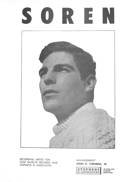
Publicity for my recording of "Summertime Romance"
for Star Satellite Records while I was a student at Dartmouth College
Today I teach over 1000 students a year about the greatness that was vaudeville and if you visit me in my office on the University of Arizona campus you will find it lined with photos of forgotten vaudevillians. Who's that, a visiting student may ask. Oh, that's Gaby Deslys, I say. She was somebody once, long before your time in a galaxy far far away!